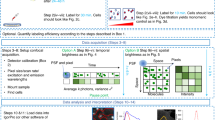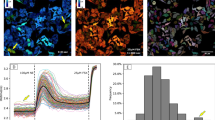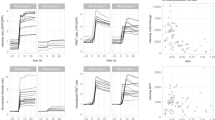Abstract
G protein–coupled receptors (GPCRs) and their ligands are traditionally characterized by radioligand-binding experiments. These experiments yield excellent quantitative data, but have low temporal and spatial resolution. In addition, the use of radioligands presents safety concerns. Here we provide a general procedure for an alternative approach with high temporal and spatial resolution, based on Tb+-labeled fluorescent receptor ligands and time-resolved fluorescence resonance energy transfer (TR-FRET). This protocol and its design are detailed here for the parathyroid hormone receptor, a class B GPCR, and its fluorescently labeled 34-amino acid peptide ligand, but it can be easily modified for other receptors and their appropriately labeled ligands. We discuss three protocol options that use Tb+-labeled fluorescent ligands: a time-resolved fluorescence separation option that works on native receptors but requires separation of bound and unbound ligand; a TR-FRET option using SNAP-tag-labeled receptors for high-throughput screening; and a TR-FRET option that uses fluorescently labeled antibodies directed against an epitope engineered into the Flag-labeled receptors' N terminus. These protocol options can be used as standard procedures with very high signal-to-background ratios in order to characterize ligands and their receptors in living cells and in cell membranes via straightforward plate-reader measurements.
This is a preview of subscription content, access via your institution
Access options
Subscribe to this journal
Receive 12 print issues and online access
$259.00 per year
only $21.58 per issue
Buy this article
- Purchase on Springer Link
- Instant access to full article PDF
Prices may be subject to local taxes which are calculated during checkout





Similar content being viewed by others
References
Lundstrom, K. Structural genomics of GPCRs. Trends Biotechnol. 23, 103–108 (2005).
Overington, J.P., Al-Lazikani, B. & Hopkins, A.L. How many drug targets are there? Nat. Rev. Drug Discov. 5, 993–996 (2006).
Rask-Andersen, M., Almen, M.S. & Schioth, H.B. Trends in the exploitation of novel drug targets. Nat. Rev. Drug Discov. 10, 579–590 (2011).
Bjarnadottir, T.K. et al. Comprehensive repertoire and phylogenetic analysis of the G protein–coupled receptors in human and mouse. Genomics 88, 263–273 (2006).
Foord, S.M. et al. International Union of Pharmacology. XLVI. G protein–coupled receptor list. Pharmacol Rev. 57, 279–288 (2005).
Lagerstrom, M.C. & Schioth, H.B. Structural diversity of G protein–coupled receptors and significance for drug discovery. Nat. Rev. Drug Discov. 7, 339–357 (2008).
Pin, J.P. & Acher, F. The metabotropic glutamate receptors: structure, activation mechanism and pharmacology. Curr. Drug Targets CNS Neurol. Disord. 1, 297–317 (2002).
Lefkowitz, R.J. Historical review: a brief history and personal retrospective of seven transmembrane receptors. Trends Pharmacol. Sci. 25, 413–422 (2004).
May, L.T. & Christopoulos, A. Allosteric modulators of G-protein–coupled receptors. Curr. Opin. Pharmacol. 3, 551–556 (2003).
Birdsall, N.J. Class A GPCR heterodimers: evidence from binding studies. Trends Pharmacol. Sci. 31, 499–508 (2010).
Christopoulos, A. & Kenakin, T. G protein–coupled receptor allosterism and complexing. Pharmacol. Rev. 54, 323–374 (2002).
Hoyer, D., Schoeffter, P., Waeber, C. & Palacios, J.M. Serotonin 5-HT1D receptors. Ann. N Y Acad. Sci. 600, 168–181 (1990).
Palacios, J.M., Mengod, G., Vilaro, M.T. & Ramm, P. Recent trends in receptor analysis techniques and instrumentation. J. Chem. Neuroanat. 4, 343–353 (1991).
Amenta, F., Ferrante, F. & Ricci, A. Pharmacological characterisation and autoradiographic localisation of dopamine receptor subtypes in the cardiovascular system and in the kidney. Hypertens Res. 18 (suppl. 1), S23–S27 (1995).
Katugampola, S.D., Kuc, R.E., Maguire, J.J. & Davenport, A.P. G-protein–coupled receptors in human atherosclerosis: comparison of vasoconstrictors (endothelin and thromboxane) with recently de-orphanized (urotensin-II, apelin and ghrelin) receptors. Clin. Sci. (Lond) 103 (suppl. 48), 171S–175S (2002).10.1042/CS103S171S
Lohse, M.J., Nuber, S. & Hoffmann, C. Fluorescence/bioluminescence resonance energy transfer techniques to study G-protein–coupled receptor activation and signaling. Pharmacol. Rev. 64, 299–336 (2012).
Selvin, P.R. Principles and biophysical applications of lanthanide-based probes. Annu. Rev. Biophys. Biomol. Struct. 31, 275–302 (2002).
Degorce, F. et al. HTRF: a technology tailored for drug discovery—a review of theoretical aspects and recent applications. Curr. Chem. Genomics 3, 22–32 (2009).
Förster, T. Zwischenmolekulare Energiewanderung und Fluoreszenz. Ann. Phys. (Leipzig) 2, 55–75 (1948).
Handl, H.L. & Gillies, R.J. Lanthanide-based luminescent assays for ligand-receptor interactions. Life Sci. 77, 361–371 (2005).
Hu, L.A., Zhou, T., Hamman, B.D. & Liu, Q. A homogeneous G protein–coupled receptor ligand binding assay based on time-resolved fluorescence resonance energy transfer. Assay Drug Dev. Technol. 6, 543–550 (2008).
Albizu, L. et al. Toward efficient drug screening by homogeneous assays based on the development of new fluorescent vasopressin and oxytocin receptor ligands. J. Med. Chem. 50, 4976–4985 (2007).
Zwier, J.M. et al. A fluorescent ligand-binding alternative using Tag-lite technology. J. Biomol. Screen 15, 1248–1259 (2010).
Leyris, J.P. et al. Homogeneous time-resolved fluorescence-based assay to screen for ligands targeting the growth hormone secretagogue receptor type 1a. Anal. Biochem. 408, 253–262 (2011).
Inglese, J. et al. Chemokine receptor-ligand interactions measured using time-resolved fluorescence. Biochemistry 37, 2372–2377 (1998).
Gao, X. et al. Europium-labeled melanin-concentrating hormone analogues: ligands for measuring binding to melanin-concentrating hormone receptors 1 and 2. Anal. Biochem. 328, 187–195 (2004).
Carter, P.H. et al. Photochemically enhanced binding of small molecules to the tumor necrosis factor receptor-1 inhibits the binding of TNF-alpha. Proc. Natl. Acad. Sci. USA 98, 11879–11884 (2001).
Mazor, O. et al. Europium-labeled epidermal growth factor and neurotensin: novel probes for receptor-binding studies. Anal. Biochem. 301, 75–81 (2002).
Takeuchi, T., Nishikawa, T., Matsukawa, R. & Matsui, J. Nonisotopic receptor assay for benzodiazepine drugs using time-resolved fluorometry. Anal. Chem. 67, 2655–2658 (1995).
Handl, H.L., Vagner, J., Yamamura, H.I., Hruby, V.J. & Gillies, R.J. Lanthanide-based time-resolved fluorescence of in cyto ligand-receptor interactions. Anal. Biochem. 330, 242–250 (2004).
Maurel, D. et al. Cell surface detection of membrane protein interaction with homogeneous time-resolved fluorescence resonance energy transfer technology. Anal. Biochem. 329, 253–262 (2004).
Kern, A., Albarran-Zeckler, R., Walsh, H.E. & Smith, R.G. Apo-ghrelin receptor forms heteromers with DRD2 in hypothalamic neurons and is essential for anorexigenic effects of DRD2 agonism. Neuron 73, 317–332 (2012).
Cottet, A. & Kontos, T. Spin quantum bit with ferromagnetic contacts for circuit QED. Phys. Rev. Lett. 105, 160502 (2010).
Jares-Erijman, E.A. & Jovin, T.M. FRET imaging. Nat. Biotechnol. 21, 1387–1395 (2003).
Miyawaki, A. Development of probes for cellular functions using fluorescent proteins and fluorescence resonance energy transfer. Annu. Rev. Biochem. 80, 357–373 (2011).
Börner, S. et al. FRET measurements of intracellular cAMP concentrations and cAMP analog permeability in intact cells. Nat. Protoc. 6, 427–438 (2011).
Baker, J.G. et al. Synthesis and characterization of high-affinity 4,4-difluoro-4-bora-3a,4a-diaza-s-indacene-labeled fluorescent ligands for human β-adrenoceptors. J. Med. Chem. 54, 6874–6887 (2011).
Nomura, W. et al. Fluorophore labeling enables imaging and evaluation of specific CXCR4-ligand interaction at the cell membrane for fluorescence-based screening. Bioconjug. Chem. 19, 1917–1920 (2008).
Kecskes, M., Kumar, T.S., Yoo, L., Gao, Z.G. & Jacobson, K.A. Novel Alexa Fluor-488 labeled antagonist of the A(2A) adenosine receptor: application to a fluorescence polarization-based receptor binding assay. Biochem. Pharmacol. 80, 506–511 (2010).
Kozma, E. et al. Novel fluorescent antagonist as a molecular probe in A3 adenosine receptor binding assays using flow cytometry. Biochem. Pharmacol. 83, 1552–1561 (2012).
Sletten, E.M. & Bertozzi, C.R. Bioorthogonal chemistry: fishing for selectivity in a sea of functionality. Angew. Chem. Int. Ed. Engl. 48, 6974–6998 (2009).
Daly, C.J. & McGrath, J.C. Fluorescent ligands, antibodies, and proteins for the study of receptors. Pharmacol. Ther. 100, 101–118 (2003).
Bazin, H., Trinquet, E. & Mathis, G. Time resolved amplification of cryptate emission: a versatile technology to trace biomolecular interactions. J. Biotechnol. 82, 233–250 (2002).
Alpha, B., Lehn, J.M. & Mathis, G. Energy-transfer luminescence of europium(iii) and terbium(iii) cryptates of macrobicyclic polypyridine ligands. Angew. Chem. Int. Edit. 26, 266–267 (1987).
Kobilka, B.K. G protein–coupled receptor structure and activation. Biochim. Biophys. Acta. 1768, 794–807 (2007).
Castro, M., Nikolaev, V.O., Palm, D., Lohse, M.J. & Vilardaga, J.P. Turn-on switch in parathyroid hormone receptor by a two-step parathyroid hormone binding mechanism. Proc. Natl. Acad. Sci. USA 102, 16084–16089 (2005).
Hoffmann, C. et al. A FlAsH-based FRET approach to determine G protein–coupled receptor activation in living cells. Nat. Methods 2, 171–176 (2005).
Maurel, D. et al. Cell-surface protein-protein interaction analysis with time-resolved FRET and snap-tag technologies: application to GPCR oligomerization. Nat. Methods 5, 561–567 (2008).
Keppler, A. et al. A general method for the covalent labeling of fusion proteins with small molecules in vivo. Nat. Biotechnol. 21, 86–89 (2003).
Albizu, L. et al. Time-resolved FRET between GPCR ligands reveals oligomers in native tissues. Nat. Chem. Biol. 6, 587–594 (2010).
Weiland, G.A. & Molinoff, P.B. Quantitative analysis of drug-receptor interactions: I. Determination of kinetic and equilibrium properties. Life Sci. 29, 313–330 (1981).
Lohse, M.J. et al. 8-Cyclopentyl-1,3-dipropylxanthine (DPCPX)—a selective high-affinity antagonist radioligand for A1 adenosine receptors. Naunyn. Schmiedebergs Arch. Pharmacol. 336, 204–210 (1987).
Klotz, K.N. et al. 2-Chloro-N6-[3H]cyclopentyladenosine ([3H]CCPA)—a high-affinity agonist radioligand for A1 adenosine receptors. Naunyn. Schmiedebergs Arch. Pharmacol. 340, 679–683 (1989).
Weber, R.G., Jones, C.R., Lohse, M.J. & Palacios, J.M. Autoradiographic visualization of A1 adenosine receptors in rat brain with 3H8-cyclopentyl-1,3-dipropylxanthine. J. Neurochem. 54, 1344–1353 (1990).
Abou-Samra, A.B. et al. Expression cloning of a common receptor for parathyroid hormone and parathyroid hormone-related peptide from rat osteoblast-like cells: a single receptor stimulates intracellular accumulation of both cAMP and inositol trisphosphates and increases intracellular free calcium. Proc. Natl. Acad. Sci. USA 89, 2732–2736 (1992).
Raisz, L.G., Lorenzo, J., Gworek, S., Kream, B. & Rosenblatt, M. Comparison of the effects of a potent synthetic analog of bovine parathyroid hormone with native bPTH-(1–84) and synthetic bPTH-(1–34) on bone resorption and collagen synthesis. Calcif. Tissue Int. 29, 215–218 (1979).
Rosenblatt, M. & Potts, J.T. Jr. Design and synthesis of parathyroid hormone analogues of enhanced biological activity. Endocr. Res. Commun. 4, 115–133 (1977).
Pioszak, A.A. & Xu, H.E. Molecular recognition of parathyroid hormone by its G protein–coupled receptor. Proc. Natl. Acad. Sci. USA 105, 5034–5039 (2008).
Jin, L. et al. Crystal structure of human parathyroid hormone 1–34 at 0.9-A resolution. J. Biol. Chem. 275, 27238–27244 (2000).
Potts, J.T. Parathyroid hormone: past and present. J. Endocrinol. 187, 311–325 (2005).
Xu, J. et al. Octadentate cages of Tb(III) 2-hydroxyisophthalamides: a new standard for luminescent lanthanide labels. J. Am. Chem. Soc. 133, 19900–19910 (2011).
Kupcho, K.R. et al. Simultaneous monitoring of discrete binding events using dual-acceptor terbium-based LRET. J. Am. Chem. Soc. 129, 13372–13373 (2007).
Dean, T., Vilardaga, J.P., Potts, J.T. Jr. & Gardella, T.J. Altered selectivity of parathyroid hormone (PTH) and PTH-related protein (PTHrP) for distinct conformations of the PTH/PTHrP receptor. Mol. Endocrinol. 22, 156–166 (2008).
Vilardaga, J.P., Bunemann, M., Krasel, C., Castro, M. & Lohse, M.J. Measurement of the millisecond activation switch of G protein–coupled receptors in living cells. Nat. Biotechnol. 21, 807–812 (2003).
Seifert, R., Wenzel-Seifert, K., Gether, U. & Kobilka, B.K. Functional differences between full and partial agonists: evidence for ligand-specific receptor conformations. J. Pharmacol. Exp. Ther. 297, 1218–1226 (2001).
Lee, C. et al. Role of the extracellular regions of the parathyroid hormone (PTH)/PTH-related peptide receptor in hormone binding. Endocrinology 135, 1488–1495 (1994).
McGrath, J.C., Arribas, S. & Daly, C.J. Fluorescent ligands for the study of receptors. Trends Pharmacol. Sci. 17, 393–399 (1996).
Daly, C.J. et al. Fluorescent ligand binding reveals heterogeneous distribution of adrenoceptors and 'cannabinoid-like' receptors in small arteries. Br. J. Pharmacol. 159, 787–796 (2010).
Lea, W.A. & Simeonov, A. Fluorescence polarization assays in small molecule screening. Expert. Opin. Drug Discov. 6, 17–32 (2011).
de Jong, L.A., Uges, D.R., Franke, J.P. & Bischoff, R. Receptor-ligand binding assays: technologies and applications. J. Chromatogr. B Analyt. Technol. Biomed. Life Sci. 829, 1–25 (2005).
Gagne, A., Banks, P. & Hurt, S.D. Use of fluorescence polarization detection for the measurement of fluopeptidetm binding to G protein–coupled receptors. J. Recept. Signal Transduct. Res. 22, 333–343 (2002).
Briddon, S.J. & Hill, S.J. Pharmacology under the microscope: the use of fluorescence correlation spectroscopy to determine the properties of ligand-receptor complexes. Trends Pharmacol. Sci. 28, 637–645 (2007).
Rose, R.H., Briddon, S.J. & Hill, S.J. A novel fluorescent histamine H1 receptor antagonist demonstrates the advantage of using fluorescence correlation spectroscopy to study the binding of lipophilic ligands. Br. J. Pharmacol. 165, 1789–1800 (2012).
Kumar, S. et al. FLIM FRET technology for drug discovery: automated multiwell-plate high-content analysis, multiplexed readouts and application in situ. Chemphyschem 12, 609–626 (2011).
Waller, A. et al. Techniques: GPCR assembly, pharmacology and screening by flow cytometry. Trends Pharmacol. Sci. 25, 663–669 (2004).
Dicker, F., Quitterer, U., Winstel, R., Honold, K. & Lohse, M.J. Phosphorylation-independent inhibition of parathyroid hormone receptor signaling by G protein–coupled receptor kinases. Proc. Natl. Acad. Sci. USA 96, 5476–5481 (1999).
Motulsky, H.J. & Neubig, R.R. Analyzing binding data. Curr. Protoc. Neurosci. 52, 7.5.1–7.5.65 (2010).10.1002/0471142301.ns0705s52
Motulsky, H.J. & Christopoulos, A. Fitting models to biological data using linear and nonlinear regression—a practical guide to curve fitting. Graphpad Software (2003).
Lohse, M.J., Lenschow, V. & Schwabe, U. Two affinity states of Ri adenosine receptors in brain membranes. Analysis of guanine nucleotide and temperature effects on radioligand binding. Mol. Pharmacol. 26, 1–9 (1984).
De Lean, A., Hancock, A.A. & Lefkowitz, R.J. Validation and statistical analysis of a computer modeling method for quantitative analysis of radioligand binding data for mixtures of pharmacological receptor subtypes. Mol. Pharmacol. 21, 5–16 (1982).
Nagasaki, K. et al. In vitro and in vivo antagonists against parathyroid hormone-related protein. Biochem. Biophys. Res. Commun. 158, 1036–1042 (1989).
Gardella, T.J., Luck, M.D., Fan, M.H. & Lee, C. Transmembrane residues of the parathyroid hormone (PTH)/PTH-related peptide receptor that specifically affect binding and signaling by agonist ligands. J. Biol. Chem. 271, 12820–12825 (1996).
Acknowledgements
Research in the authors' laboratory is supported by the DFG (grant no. SFB 487 to M.J.L.) and the Bayerische Forschungsstiftung (fellowship to A.E.-N.).
Author information
Authors and Affiliations
Contributions
A.E.-N., T.R. and M.L. performed the experiments and analyzed the data; L.L. and E.B. labeled PTHs; A.E.-N., E.T. and M.J.L. wrote the paper.
Corresponding author
Ethics declarations
Competing interests
E.B., M.L., L.L., T.R. and E.T. are employees of Cisbio Bioassays.
Supplementary information
Supplementary Figure 1
cAMP accumulation by [C13-Tb3+]PTH'(1-34) and dissociation of [C35-d2]PTH'(1-34) from SNAP-PTHR. (a) cAMP accumulation by [C13-Tb3+]PTH'(1-34). [C13-Tb3+]PTH'(1-34) was tested in a cell-based cAMP radioimmuno assay. PTHR expressing HEK 293 ad cells generated similar cAMP amounts upon stimulation with 100 pM [C13-Tb3+]PTH'(1-34) or PTH'(1-34). Error bars represent SEM, n=3. (b) Dissociation of [C35-d2]PTH'(1-34) from SNAP-PTHR. SNAP-PTHR expressing HEK 293 ad cells were grown on 96-well plates, labeled with benzylguanine-Tb3+-cryptate and incubated with 5 nM [C35-d2]PTH'(1-34) for 4 h at 20 °C. Cells were washed three times with 100 μl Tag-lite medium within 3 min and 100 μl Tag-Lite labeling medium (assay buffer) or 100 μl assay buffer containing 1 μM PTH'(1-34) was added. Cells were incubated at 20 °C and TR-FRET ratios were measured at indicated time intervals using the Envision reader at 5 point scan mode. A representative experiment is shown. Error bars represent SEM of quadruplicates. (PDF 900 kb)
Rights and permissions
About this article
Cite this article
Emami-Nemini, A., Roux, T., Leblay, M. et al. Time-resolved fluorescence ligand binding for G protein–coupled receptors. Nat Protoc 8, 1307–1320 (2013). https://doi.org/10.1038/nprot.2013.073
Published:
Issue Date:
DOI: https://doi.org/10.1038/nprot.2013.073
This article is cited by
-
Yeast-based directed-evolution for high-throughput structural stabilization of G protein-coupled receptors (GPCRs)
Scientific Reports (2022)
-
A review on cullin neddylation and strategies to identify its inhibitors for cancer therapy
3 Biotech (2022)
-
Determination of G-protein–coupled receptor oligomerization by molecular brightness analyses in single cells
Nature Protocols (2021)
-
Fluorescent ligands for dopamine D2/D3 receptors
Scientific Reports (2020)
-
Ultrasensitive optical imaging with lanthanide lumiphores
Nature Chemical Biology (2018)
Comments
By submitting a comment you agree to abide by our Terms and Community Guidelines. If you find something abusive or that does not comply with our terms or guidelines please flag it as inappropriate.



